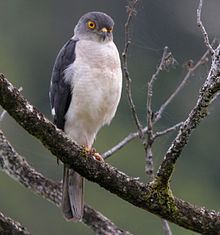Kingdom Animalia Order Accipitriformes Genus Accipiter Higher classification Accipiter | Phylum Chordata Family Accipitridae Scientific name Accipiter francesiae Rank Species | |
 | ||
Similar Madagascan sparrowhawk, Henst's goshawk, Chestnut‑flanked sparrowhawk, Red‑thighed sparrowhawk, Nicobar sparrowhawk | ||
Frances s sparrowhawk and paradise flycatcher male
Frances's sparrowhawk (Accipiter francesiae) is a small bird of prey. The nominate subspecies, A. f. francesiae, is endemic to Madagascar.
Contents
- Frances s sparrowhawk and paradise flycatcher male
- Appearance
- Diet
- Habitat
- Reproduction
- Threats
- References
The name commemorates Lady Frances Cole (died 1847), wife of the Cape Colony governor Lowry Cole.
Appearance
It is grey with a light belly. It has orange eyes and feet, a yellow cere and a black beak. The size of each hawk varies from 28 – 35 cm for a male and 104 – 140 g for a female 112 – 185 g and their wingspan is around 40 – 54 cm.
Diet
The hawks feed on a range range of prey including mammals, birds, lizards, frogs, and large insects. They knock small mammals, lizards and frog off trees or trunks of trees to shock them and then make the kill. They generally attack flying insects and birds flying straight towards the prey and catching them in mid-flight.
Habitat
The France's Sparrow-Hawk is found only in Madagascar and live in dense forests, large gardens, parks and coconut plantations. They live mostly on the edges of forests and
Reproduction
The sparrow-hawks build large stick nests in the upper fork of large trees usually 5 - 15m from the ground. The location of the nests change from year to year and they usually breed in October to December the clutch varies from 3 - 4 eggs they measure around 37 x 29 mm but the average survival rate of the eggs is 1.5. Eggs usually have different and unique marking on them. The eggs are usually a greyish-white.
Threats
The Frances's sparrowhawk has no real predators. At one point during the 1900s to 1980s, however, it did look like the hawks would go extinct because of chemicals that had been poisoning the hawk. After these chemicals were banned, the hawks' numbers slowly increased and now it is estimated that more than 32,000 breeding pairs live throughout Madagascar. So apart from the occasional hunt from the local villagers in Madagascar, the population of Frances's sparrowhawks is very stable.
